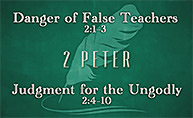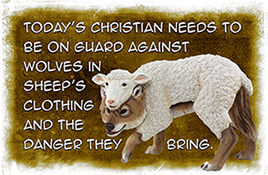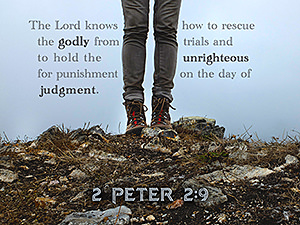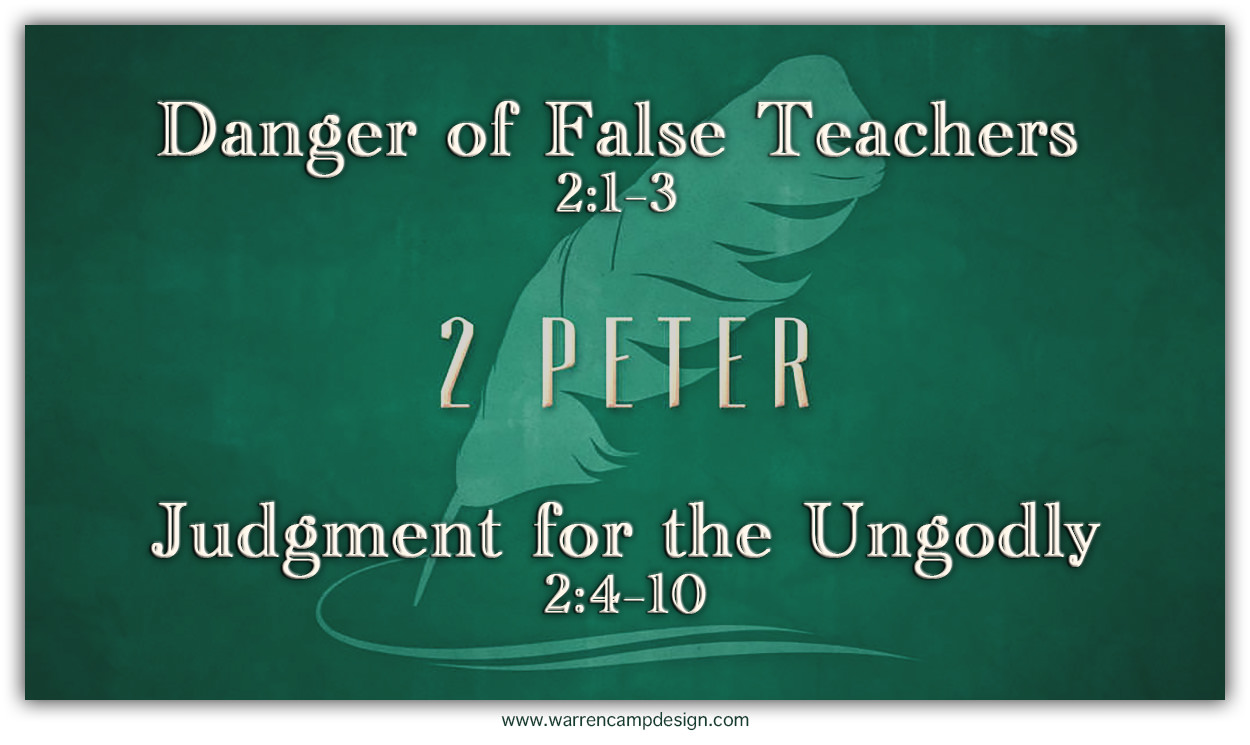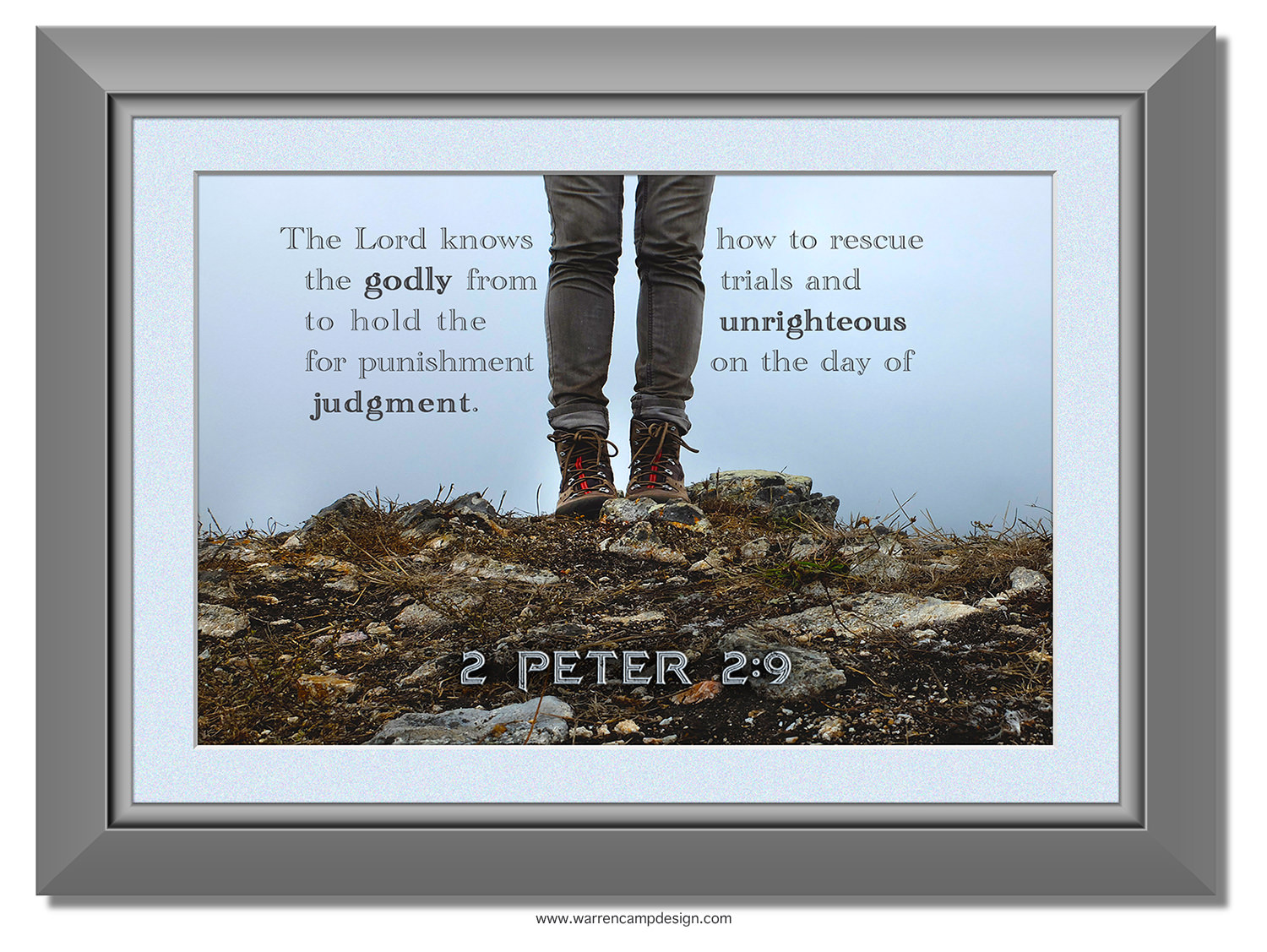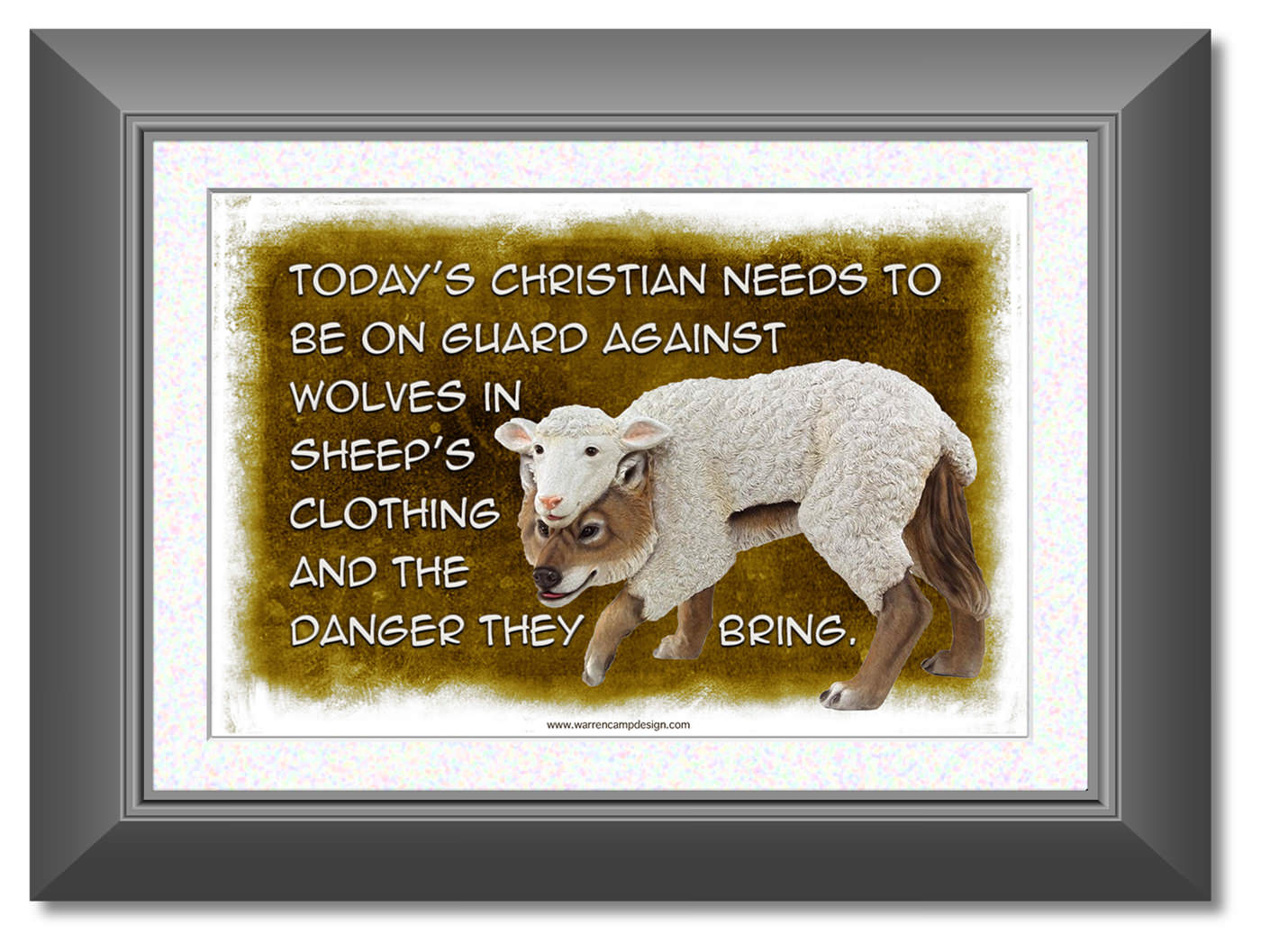
by Warren Camp
2 Peter 2:1–10a . . .
“False Teachers: Judgment for the Ungodly”
In the previous passage (highlighted in Warren’s commentary on 1:19–21), Peter warned his readers to pay close attention to the completely reliable prophetic message so that they’d successfully keep from being swayed by other teachings. In today’s nine-verse passage, he warns his readers about false teachers who’ve already come. One of Satan’s methods of attack against followers of God is to infiltrate and mislead them, using people who claim they’re working for the Lord.
Note: There are numerous types of false prophets. A number clearly work for the enemy (like Baal’s 450 prophets highlighted in 1 Kings 18) while others claim that they’re serving God but, in fact, are wolves in disguise (as Jesus warned in Matthew 7:15). We Christians must always be on guard for them and their teachings while upholding the truth of Scripture.
False teachers are false prophets; no matter their title, they’re those who, for several reasons, have opted to deceive God’s people. Peter now provides three powerful verses that speak decisively about and against false teachers and prophets. They not only reveal to us the jaded character of a false prophet, but also show us how dangerous it is to be swayed by such a person.
False Teachers Are Dangerous! (2:1–3)
False Teachers and Their Destruction
2 1But there were also false prophets among the people, just as there will be false teachers among you. They will secretly introduce destructive heresies, even denying the sovereign Lord who bought them — bringing swift destruction on themselves. 2Many will follow their depraved conduct and will bring the way of truth into disrepute. 3In their greed these teachers will exploit you with fabricated stories. Their condemnation has long been hanging over them, and their destruction has not been sleeping (2 Pet. 2:1–3 NIV).
“But there were also false prophets among the people” speaks to the fact that, even as there were “prophets, though human, [who] spoke from God as they were carried along by the Holy Spirit” (2 Pet. 1:21), there were also false prophets and false teachers then (as well as today). Peter stated this as a fact, not as a possibility; he alerted his saints that false teachers were and “will be . . . among you,” both inside and outside the church. Their prophecies, having originated from people’s own imagination, will continue to pervert many.
Peter writes in v. 2 that false teachers may become popular as they attract crowds of followers. He adds a most distressing fact: “Many [Christians] will follow [false prophets’] depraved conduct and bring the way of truth into disrepute.” Then in v. 3, he reveals that false teachers use greed (their own and that of their followers) while presenting a fabricated gospel account with self-gratification at its core.
Jesus warns us that “false messiahs and false prophets” will come, attempting to deceive even God’s elect (Matt. 24:23–27). For those of us who are professed believers, the best way to guard ourselves against falsehood and false teachers is to know the truth. To spot a counterfeit, study the real thing. Any believer who “correctly handles the word of truth” (2 Timothy 2:15) and who makes a careful study of the Bible can identify false doctrine. For example, a believer who’s read the activities of the Father, Son, and Holy Spirit in Matt. 3:16–17 will immediately question any doctrine that denies the Trinity. Therefore, the primary step is to study the Bible, judging all teaching by what the Scripture says.
Is there a difference between a “false teacher” and a teacher who is teaching something that’s false? In truth, a false teacher is a false teacher when he or she teaches falsehood. There’s a notable difference between a false teaching and a false teacher. Virtually any preacher, especially a new one, will teach something that’s false. That’s acceptable, so long as he or she realizes the error and agrees to correct it. However, it’s quite different with a “false teacher” who remains uncorrected and uncorrectable. RC Sproul distinguishes between correctable errors and outright heresies: “There’s a difference between error and heresy. It’s heresy that strikes at the very heart of the gospel and of the truth.”
Wolves in sheep’s clothing are dangerous. They cause instability in those children of God who are unprepared to deal with deceptive promotions. The unprepared are those who are undiscerning. While every child of God has a measure of discernment (thanks to the indwelt Holy Spirit), our spiritual senses must continually be sharpened by diligently reading and understanding God’s Word. Christians who fail to read Scripture devotedly permit false teachings to take hold. They don’t need to be scholars or seminary students. But they must remain equipped, ready to stand against heresies and demonic doctrines. Because wolves in sheep’s clothing inevitably present themselves to everyone, we must fully utilize God’s Holy Word, which is “alive, active, and sharper than a double-edge sword” (Hebrews 4:12). The Word of God has the power to repel every false prophecy and teaching of false prophets. While Peter has already shown us that Satan himself is like a roaring lion (1 Pet. 5:8), here he compares false teachers to ravenous wolves.
Judgment for the Ungodly (vv. 4–8)
Redirecting his focus from false teachers, Peter now begins his next segment by highlighting three historical examples of God’s judgment and condemnation of the wicked (while noting in v. 7 that the righteous were spared). Each of these cases is an egregious example of someone committing abominations against God’s designed order of things. Sin, of course, has existed since the fall and will be ultimately judged. But some sins go so far as to upset God’s natural order and design that he doesn’t wait till judgment day; he actively sets warning examples that: (1) his patience and mercy have limits and (2) he should never be tested!
4For if God did not spare angels when they sinned, but sent them to hell, putting them in chains of darkness to be held for judgment; 5if he did not spare the ancient world when he brought the flood on its ungodly people, but protected Noah, a preacher of righteousness, and seven others; 6if he condemned the cities of Sodom and Gomorrah by burning them to ashes, and made them an example of what is going to happen to the ungodly; 7and if he rescued Lot, a righteous man, who was distressed by the depraved conduct of the lawless 8(for that righteous man, living among them day after day, was tormented in his righteous soul by the lawless deeds he saw and heard) — (2 Pet. 2:4–8).
Apostle Peter now proceeds to prove the proposition that these persons would be punished. Remember: They’d been, or were even then, professing Christians. In the next few verses, his promise that God is already preparing the right judgment for the wicked becomes evident. We’ll first look back at three Old Testament scenes. Then Peter’s concluding epilogue will teach this truth: God knows what he’s doing; if it seems things can’t possibly be made right, or that evil has triumphed, or that God has been beaten, keep your eyes open. Peter will make his point through repetition; in each scene, the righteous are preserved while the unrepentant wicked are judged and condemned.
Scene 1: Peter’s first example shows that God will punish unrepentant sinners while vindicating the righteous. He goes way back to Genesis 6. In v. 4 of this second letter, he cites “sons of God” as spared-fallen angels first recounted by Moses in Gen. 6:1–4, then in v. 6 of Jude’s brief letter.
Scene 2: Peter’s next scene is also derived from Gen. 6 (v. 5), which highlights the account of Noah and the flood. It evokes salvation and judgment. Herein, Peter makes a specific point that he makes in all three scenes: The Lord is righteous in matters of salvation and judgment. As a result, Noah heard God, believed him, and acted on his word while the wicked people among whom he lived were judged and rightly condemned and exterminated, as we see in Gen. 6:5–8. Who were preserved and safeguarded? Noah and his wife, his three sons and their wives, eight in all, plus pairs of unclean animals and seven pairs of clean animals. Who were judged and damned? Everyone and everything else was destroyed by the flood!
Scene 3: The third scene, also taken from Genesis (chpts. 18 and 19) and Jude 7, points to the stories of Sodom and Gomorrah and Abraham’s nephew, Lot, and his family. The destruction of Sodom and Gomorrah is a well-known picture of judgment leading to complete destruction. We find this event also mentioned in Isaiah, quoted by Paul in Romans 9, and propounded by Jesus in Matthew 10. The Genesis account clearly demonstrates that God wouldn’t tolerate the wickedness of the people of Sodom and Gomorrah any longer. In scene 3, who were preserved and safeguarded? Lot and his two daughters. Who were judged and damned? The people and the cities of Sodom and Gomorrah; all of each wicked element was ignited and turned to ash and smoke. Peter emphasized this reaction in graphic terms: Father God condemned the wicked to extinction.
Clearly, it’s not evident from Scripture that Lot was “a righteous man” (v. 7). But he’s a reminder that no-one has righteousness of themselves. Lot’s righteousness was imputed to him the same way Abraham’s was — through faith.
Peter gives these historical examples to warn the false teachers what’s in store for them. The examples should also comfort believers, knowing that God is always watching and will definitely deal with wicked people appropriately. God is well aware of what goes on in this world. Thankfully, he’ll deal punishingly with every wolf who attempts to hurt the Lord’s vulnerable sheep.
The Lord’s Lesson to Be Learned (vv. 9–10a)
Peter finally concludes his long “if” statement by arriving at his “then,” which becomes his conclusion.
. . . 9if this is so, then the Lord knows how to rescue the godly from trials and to hold the unrighteous for punishment on the day of judgment. 10This is especially true of those who follow the corrupt desire of the flesh and despise authority (2 Pet. 2:9–10a).
God remains patient. “The Lord knows how to rescue the godly from trials.” They get rescued, delivered, protected, preserved from burdens. But “the unrighteous” are held by God for their “punishment on the day of judgment.” Peter calls out two specific sins of the unrighteous: (1) They reject God’s righteousness by engaging in lustful, sinful, sexual behavior that defiles the sinner and (2) they reject God’s authority and lordship. Verse 10a’s ungodly ones are especially reserved for judgment because they live according to the flesh, not the spirit. Being proud, they despise authority.
Two important principles to remember: (1) Peter makes it clear that the events of ancient times are relevant and applicable to us today; God is able and willing to judge the wicked while rescuing the righteous from temptation; (2) the principle of judgment and deliverance, demonstrated in the flood and the destruction of Sodom and Gomorrah, wasn’t invented by Peter; it’s a theme frequently referred to by Old Testament prophets, by our Lord, and by other New Testament writers. Christ’s righteousness will save, sanctify, and keep us believers from temptation and judgment.
- Q. 1 What’s needed to recognize a false teacher?
- Q. 2 Why are heresies destructive?
- Q. 3 Why do you think Peter calls Lot a “righteous man”?
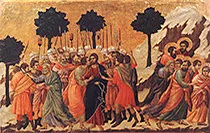
‘Betrayal of Jesus’ by Duccio
Click to open “Peter Masterpieces.”
Summary Video: “Second Peter”
† Watch this overview video of Second Peter created by BibleProject.
Warren’s New “Peter Masterpieces” Photo Album
† View several classic paintings of Saint Peter by art world masters: Rembrandt, Michelangelo, Da Vinci, Rubens, Goya, El Greco, Raphael, Masaccio, Giotto, Correggio, Tintoretto, Caravaggio, Veneziano, Tissot, Duccio, Fra Angelico, Galle, Duccio, Dürer, Palomino, and many more.
2 Peter 2:1–10a
New International Version (NIV) or view it in a different version by clicking here.
— Listen to chapter 2, narrated by Max McLean.

